Human Resource Management Report - XYZ Limited HRM Analysis
VerifiedAdded on 2020/06/04
|18
|6030
|76
Report
AI Summary
This report provides a comprehensive analysis of Human Resource Management (HRM) within the context of XYZ Limited, addressing key functions such as planning, training and development, staffing, performance appraisal, compensation, job analysis, and labor relations. It examines the purpose of HRM, including its role in aligning workforce efforts with organizational objectives. The report delves into different approaches to recruitment and selection, evaluating their strengths and weaknesses, and explores the benefits of HRM practices for both employers and employees. It also highlights the significance of employee relations and employment legislation, analyzing their impact on HRM decision-making. Furthermore, the report assesses the application of HRM practices in a work-related context and critically evaluates how these practices influence decision-making processes. The analysis considers the impact of technology and different HRM approaches like hard and soft HRM, as well as best-fit and best approaches to workforce planning, offering insights into restructuring and the adoption of effective HRM strategies.
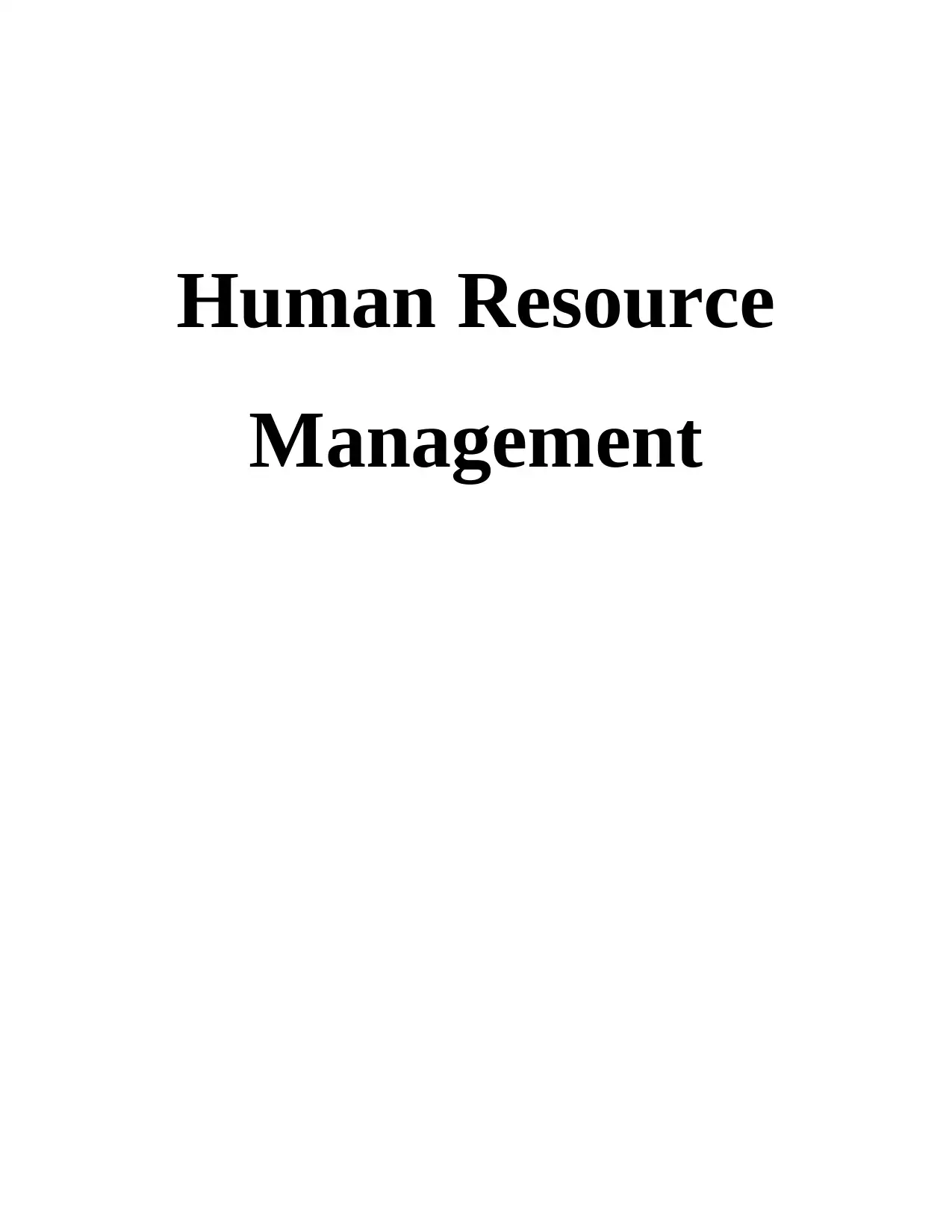
Human Resource
Management
Management
Paraphrase This Document
Need a fresh take? Get an instant paraphrase of this document with our AI Paraphraser
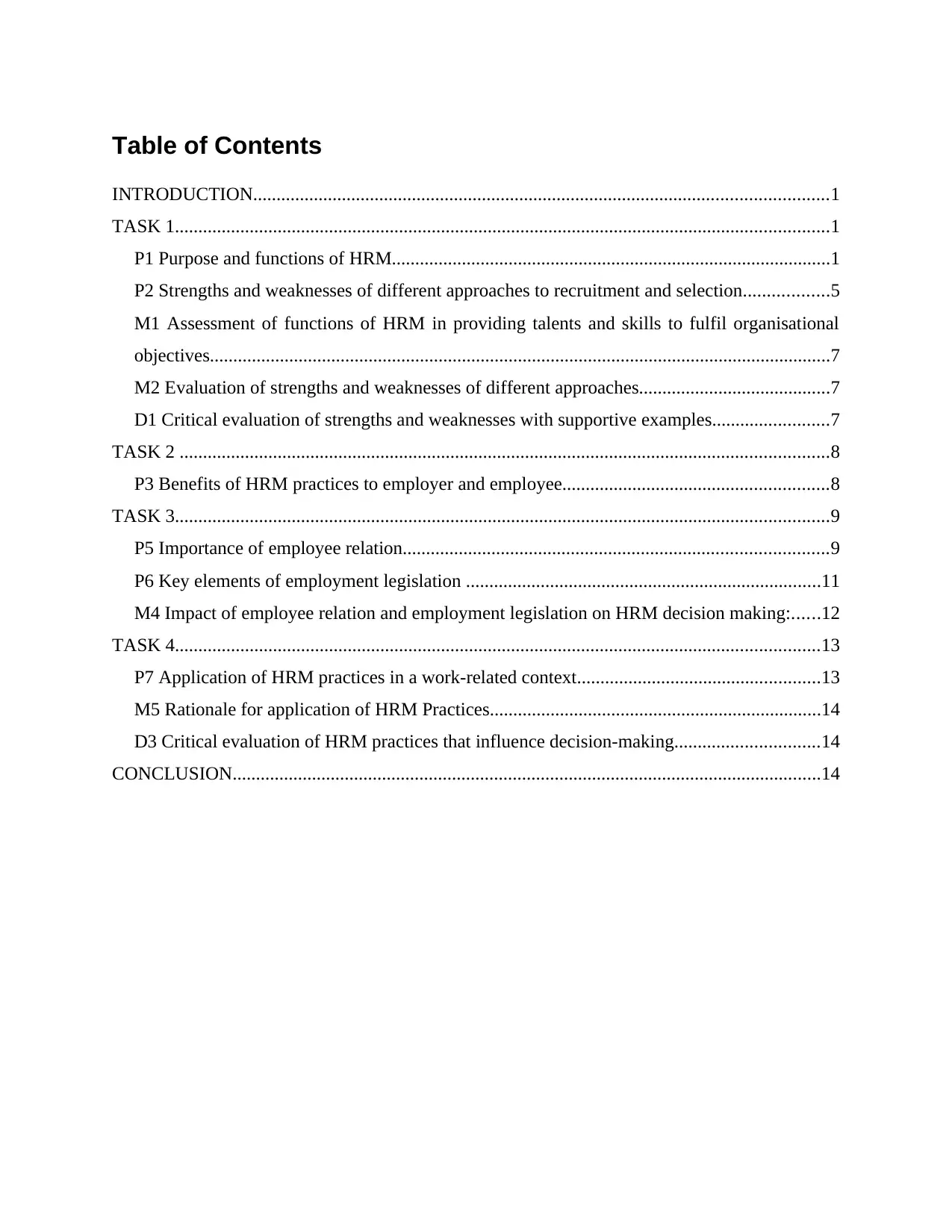
Table of Contents
INTRODUCTION...........................................................................................................................1
TASK 1............................................................................................................................................1
P1 Purpose and functions of HRM..............................................................................................1
P2 Strengths and weaknesses of different approaches to recruitment and selection..................5
M1 Assessment of functions of HRM in providing talents and skills to fulfil organisational
objectives.....................................................................................................................................7
M2 Evaluation of strengths and weaknesses of different approaches.........................................7
D1 Critical evaluation of strengths and weaknesses with supportive examples.........................7
TASK 2 ...........................................................................................................................................8
P3 Benefits of HRM practices to employer and employee.........................................................8
TASK 3............................................................................................................................................9
P5 Importance of employee relation...........................................................................................9
P6 Key elements of employment legislation ............................................................................11
M4 Impact of employee relation and employment legislation on HRM decision making:......12
TASK 4..........................................................................................................................................13
P7 Application of HRM practices in a work-related context....................................................13
M5 Rationale for application of HRM Practices.......................................................................14
D3 Critical evaluation of HRM practices that influence decision-making...............................14
CONCLUSION..............................................................................................................................14
INTRODUCTION...........................................................................................................................1
TASK 1............................................................................................................................................1
P1 Purpose and functions of HRM..............................................................................................1
P2 Strengths and weaknesses of different approaches to recruitment and selection..................5
M1 Assessment of functions of HRM in providing talents and skills to fulfil organisational
objectives.....................................................................................................................................7
M2 Evaluation of strengths and weaknesses of different approaches.........................................7
D1 Critical evaluation of strengths and weaknesses with supportive examples.........................7
TASK 2 ...........................................................................................................................................8
P3 Benefits of HRM practices to employer and employee.........................................................8
TASK 3............................................................................................................................................9
P5 Importance of employee relation...........................................................................................9
P6 Key elements of employment legislation ............................................................................11
M4 Impact of employee relation and employment legislation on HRM decision making:......12
TASK 4..........................................................................................................................................13
P7 Application of HRM practices in a work-related context....................................................13
M5 Rationale for application of HRM Practices.......................................................................14
D3 Critical evaluation of HRM practices that influence decision-making...............................14
CONCLUSION..............................................................................................................................14
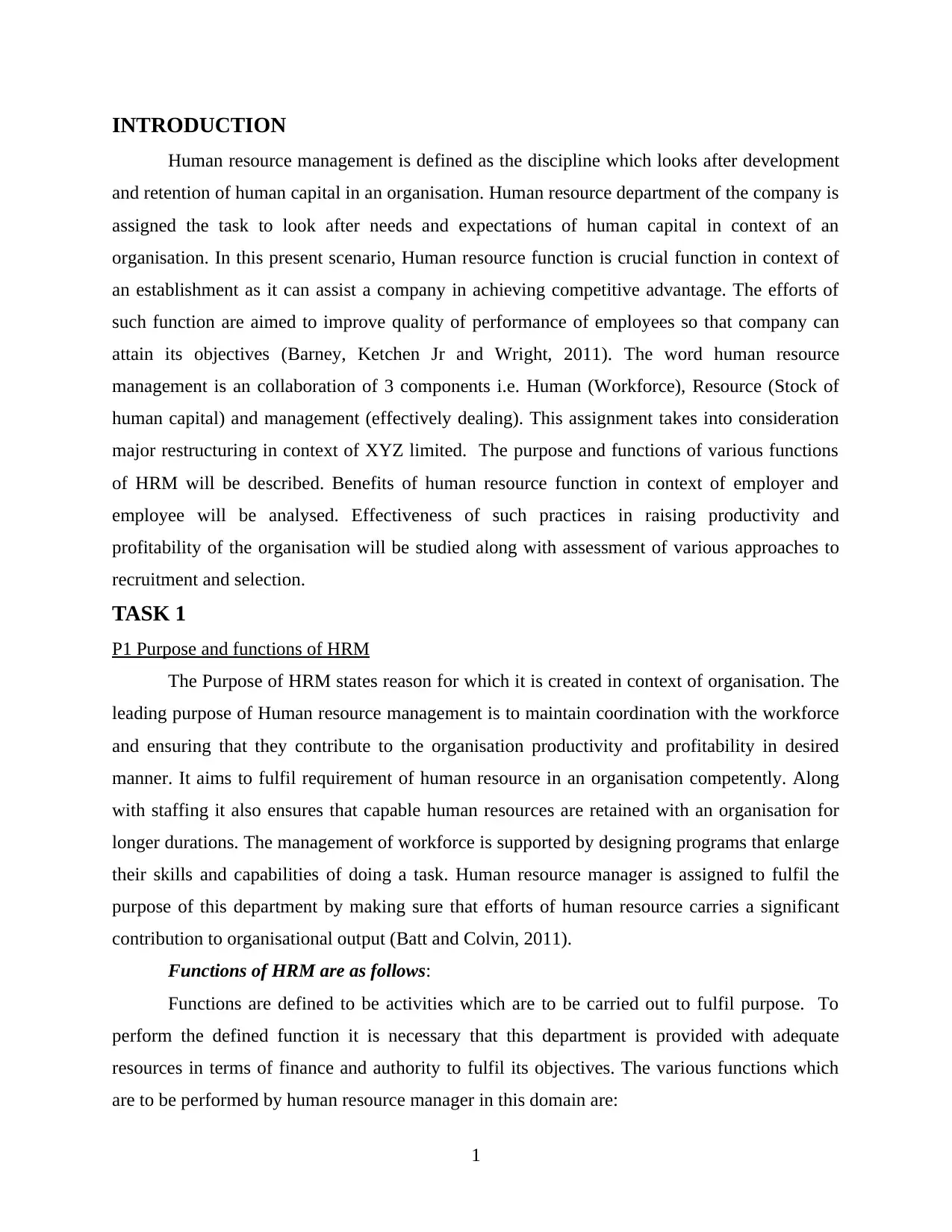
INTRODUCTION
Human resource management is defined as the discipline which looks after development
and retention of human capital in an organisation. Human resource department of the company is
assigned the task to look after needs and expectations of human capital in context of an
organisation. In this present scenario, Human resource function is crucial function in context of
an establishment as it can assist a company in achieving competitive advantage. The efforts of
such function are aimed to improve quality of performance of employees so that company can
attain its objectives (Barney, Ketchen Jr and Wright, 2011). The word human resource
management is an collaboration of 3 components i.e. Human (Workforce), Resource (Stock of
human capital) and management (effectively dealing). This assignment takes into consideration
major restructuring in context of XYZ limited. The purpose and functions of various functions
of HRM will be described. Benefits of human resource function in context of employer and
employee will be analysed. Effectiveness of such practices in raising productivity and
profitability of the organisation will be studied along with assessment of various approaches to
recruitment and selection.
TASK 1
P1 Purpose and functions of HRM
The Purpose of HRM states reason for which it is created in context of organisation. The
leading purpose of Human resource management is to maintain coordination with the workforce
and ensuring that they contribute to the organisation productivity and profitability in desired
manner. It aims to fulfil requirement of human resource in an organisation competently. Along
with staffing it also ensures that capable human resources are retained with an organisation for
longer durations. The management of workforce is supported by designing programs that enlarge
their skills and capabilities of doing a task. Human resource manager is assigned to fulfil the
purpose of this department by making sure that efforts of human resource carries a significant
contribution to organisational output (Batt and Colvin, 2011).
Functions of HRM are as follows:
Functions are defined to be activities which are to be carried out to fulfil purpose. To
perform the defined function it is necessary that this department is provided with adequate
resources in terms of finance and authority to fulfil its objectives. The various functions which
are to be performed by human resource manager in this domain are:
1
Human resource management is defined as the discipline which looks after development
and retention of human capital in an organisation. Human resource department of the company is
assigned the task to look after needs and expectations of human capital in context of an
organisation. In this present scenario, Human resource function is crucial function in context of
an establishment as it can assist a company in achieving competitive advantage. The efforts of
such function are aimed to improve quality of performance of employees so that company can
attain its objectives (Barney, Ketchen Jr and Wright, 2011). The word human resource
management is an collaboration of 3 components i.e. Human (Workforce), Resource (Stock of
human capital) and management (effectively dealing). This assignment takes into consideration
major restructuring in context of XYZ limited. The purpose and functions of various functions
of HRM will be described. Benefits of human resource function in context of employer and
employee will be analysed. Effectiveness of such practices in raising productivity and
profitability of the organisation will be studied along with assessment of various approaches to
recruitment and selection.
TASK 1
P1 Purpose and functions of HRM
The Purpose of HRM states reason for which it is created in context of organisation. The
leading purpose of Human resource management is to maintain coordination with the workforce
and ensuring that they contribute to the organisation productivity and profitability in desired
manner. It aims to fulfil requirement of human resource in an organisation competently. Along
with staffing it also ensures that capable human resources are retained with an organisation for
longer durations. The management of workforce is supported by designing programs that enlarge
their skills and capabilities of doing a task. Human resource manager is assigned to fulfil the
purpose of this department by making sure that efforts of human resource carries a significant
contribution to organisational output (Batt and Colvin, 2011).
Functions of HRM are as follows:
Functions are defined to be activities which are to be carried out to fulfil purpose. To
perform the defined function it is necessary that this department is provided with adequate
resources in terms of finance and authority to fulfil its objectives. The various functions which
are to be performed by human resource manager in this domain are:
1
⊘ This is a preview!⊘
Do you want full access?
Subscribe today to unlock all pages.

Trusted by 1+ million students worldwide
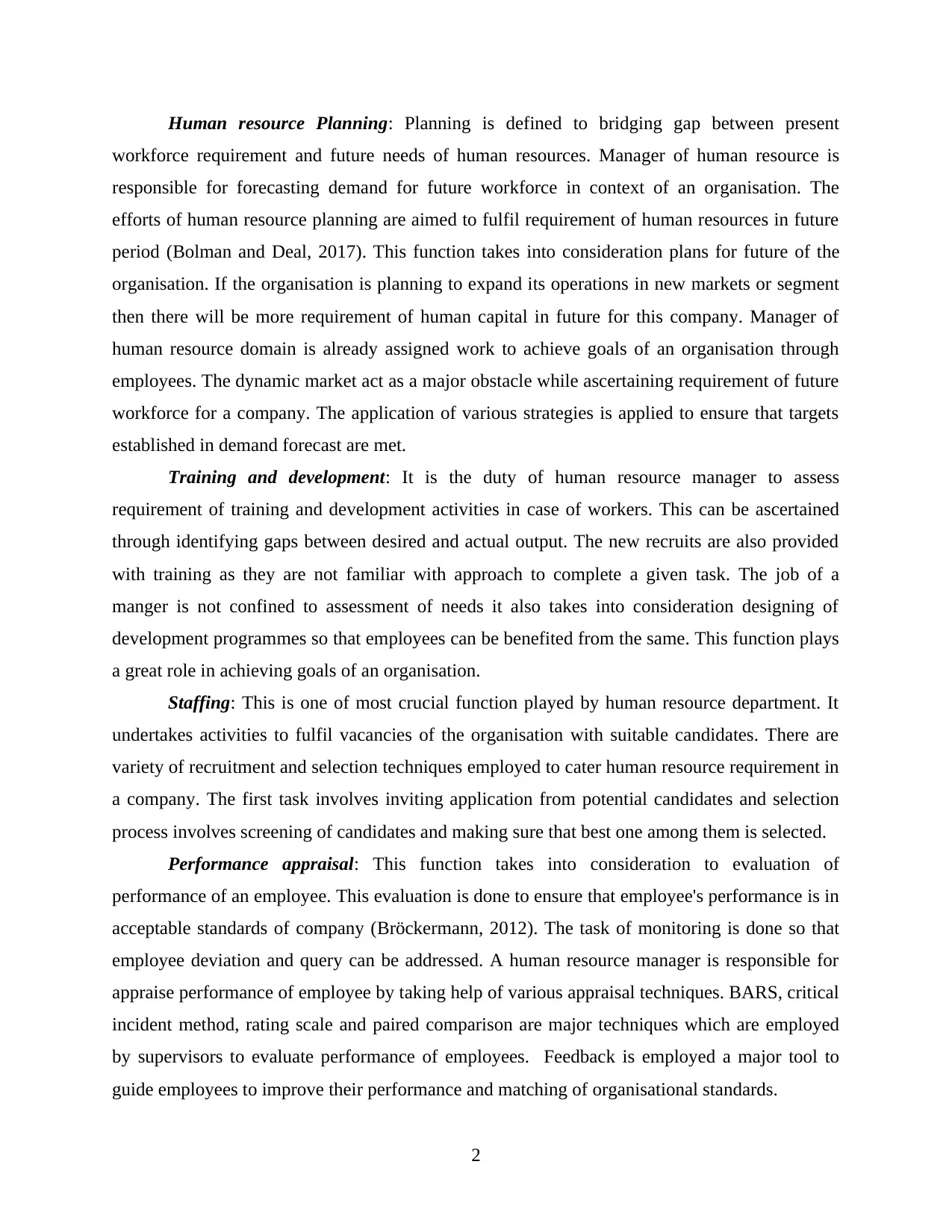
Human resource Planning: Planning is defined to bridging gap between present
workforce requirement and future needs of human resources. Manager of human resource is
responsible for forecasting demand for future workforce in context of an organisation. The
efforts of human resource planning are aimed to fulfil requirement of human resources in future
period (Bolman and Deal, 2017). This function takes into consideration plans for future of the
organisation. If the organisation is planning to expand its operations in new markets or segment
then there will be more requirement of human capital in future for this company. Manager of
human resource domain is already assigned work to achieve goals of an organisation through
employees. The dynamic market act as a major obstacle while ascertaining requirement of future
workforce for a company. The application of various strategies is applied to ensure that targets
established in demand forecast are met.
Training and development: It is the duty of human resource manager to assess
requirement of training and development activities in case of workers. This can be ascertained
through identifying gaps between desired and actual output. The new recruits are also provided
with training as they are not familiar with approach to complete a given task. The job of a
manger is not confined to assessment of needs it also takes into consideration designing of
development programmes so that employees can be benefited from the same. This function plays
a great role in achieving goals of an organisation.
Staffing: This is one of most crucial function played by human resource department. It
undertakes activities to fulfil vacancies of the organisation with suitable candidates. There are
variety of recruitment and selection techniques employed to cater human resource requirement in
a company. The first task involves inviting application from potential candidates and selection
process involves screening of candidates and making sure that best one among them is selected.
Performance appraisal: This function takes into consideration to evaluation of
performance of an employee. This evaluation is done to ensure that employee's performance is in
acceptable standards of company (Bröckermann, 2012). The task of monitoring is done so that
employee deviation and query can be addressed. A human resource manager is responsible for
appraise performance of employee by taking help of various appraisal techniques. BARS, critical
incident method, rating scale and paired comparison are major techniques which are employed
by supervisors to evaluate performance of employees. Feedback is employed a major tool to
guide employees to improve their performance and matching of organisational standards.
2
workforce requirement and future needs of human resources. Manager of human resource is
responsible for forecasting demand for future workforce in context of an organisation. The
efforts of human resource planning are aimed to fulfil requirement of human resources in future
period (Bolman and Deal, 2017). This function takes into consideration plans for future of the
organisation. If the organisation is planning to expand its operations in new markets or segment
then there will be more requirement of human capital in future for this company. Manager of
human resource domain is already assigned work to achieve goals of an organisation through
employees. The dynamic market act as a major obstacle while ascertaining requirement of future
workforce for a company. The application of various strategies is applied to ensure that targets
established in demand forecast are met.
Training and development: It is the duty of human resource manager to assess
requirement of training and development activities in case of workers. This can be ascertained
through identifying gaps between desired and actual output. The new recruits are also provided
with training as they are not familiar with approach to complete a given task. The job of a
manger is not confined to assessment of needs it also takes into consideration designing of
development programmes so that employees can be benefited from the same. This function plays
a great role in achieving goals of an organisation.
Staffing: This is one of most crucial function played by human resource department. It
undertakes activities to fulfil vacancies of the organisation with suitable candidates. There are
variety of recruitment and selection techniques employed to cater human resource requirement in
a company. The first task involves inviting application from potential candidates and selection
process involves screening of candidates and making sure that best one among them is selected.
Performance appraisal: This function takes into consideration to evaluation of
performance of an employee. This evaluation is done to ensure that employee's performance is in
acceptable standards of company (Bröckermann, 2012). The task of monitoring is done so that
employee deviation and query can be addressed. A human resource manager is responsible for
appraise performance of employee by taking help of various appraisal techniques. BARS, critical
incident method, rating scale and paired comparison are major techniques which are employed
by supervisors to evaluate performance of employees. Feedback is employed a major tool to
guide employees to improve their performance and matching of organisational standards.
2
Paraphrase This Document
Need a fresh take? Get an instant paraphrase of this document with our AI Paraphraser
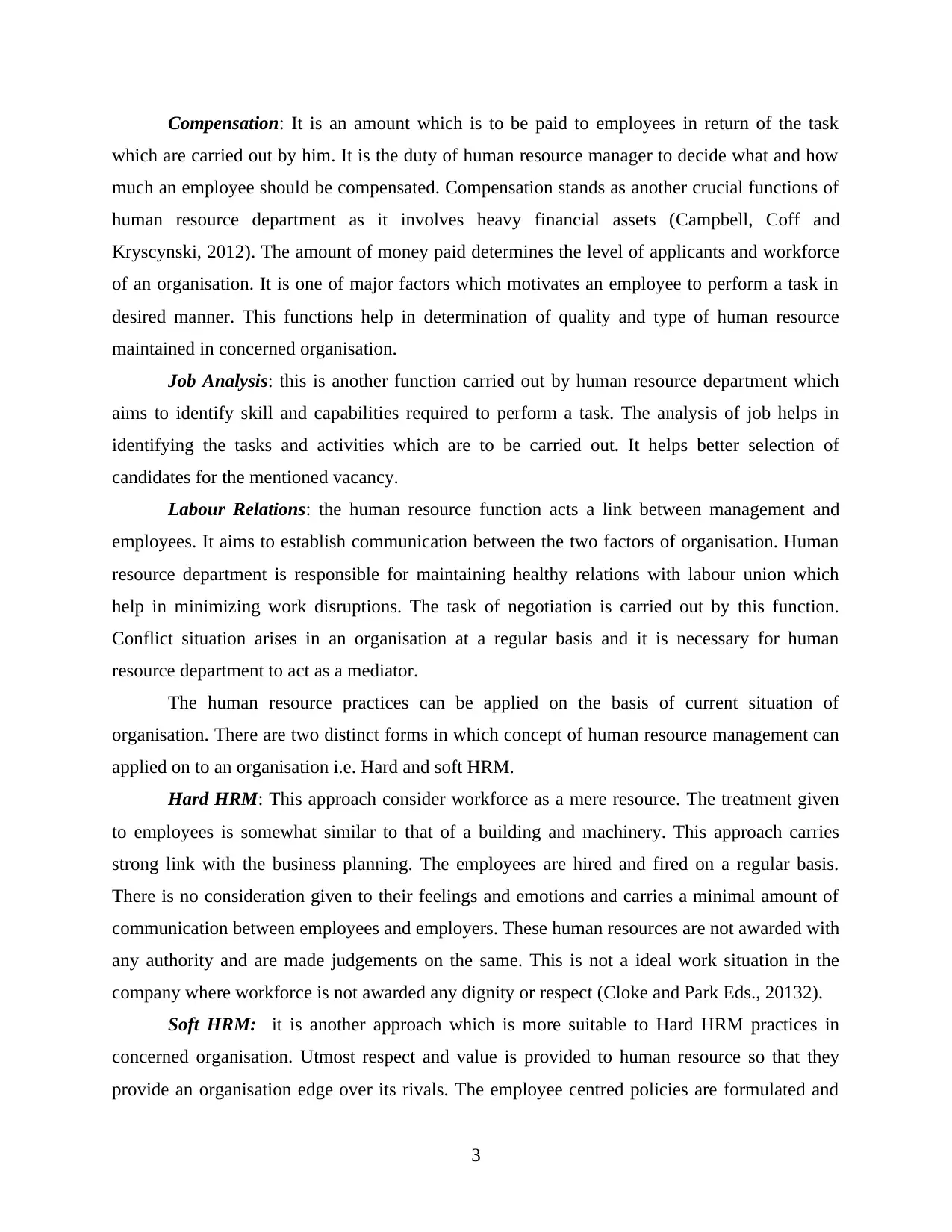
Compensation: It is an amount which is to be paid to employees in return of the task
which are carried out by him. It is the duty of human resource manager to decide what and how
much an employee should be compensated. Compensation stands as another crucial functions of
human resource department as it involves heavy financial assets (Campbell, Coff and
Kryscynski, 2012). The amount of money paid determines the level of applicants and workforce
of an organisation. It is one of major factors which motivates an employee to perform a task in
desired manner. This functions help in determination of quality and type of human resource
maintained in concerned organisation.
Job Analysis: this is another function carried out by human resource department which
aims to identify skill and capabilities required to perform a task. The analysis of job helps in
identifying the tasks and activities which are to be carried out. It helps better selection of
candidates for the mentioned vacancy.
Labour Relations: the human resource function acts a link between management and
employees. It aims to establish communication between the two factors of organisation. Human
resource department is responsible for maintaining healthy relations with labour union which
help in minimizing work disruptions. The task of negotiation is carried out by this function.
Conflict situation arises in an organisation at a regular basis and it is necessary for human
resource department to act as a mediator.
The human resource practices can be applied on the basis of current situation of
organisation. There are two distinct forms in which concept of human resource management can
applied on to an organisation i.e. Hard and soft HRM.
Hard HRM: This approach consider workforce as a mere resource. The treatment given
to employees is somewhat similar to that of a building and machinery. This approach carries
strong link with the business planning. The employees are hired and fired on a regular basis.
There is no consideration given to their feelings and emotions and carries a minimal amount of
communication between employees and employers. These human resources are not awarded with
any authority and are made judgements on the same. This is not a ideal work situation in the
company where workforce is not awarded any dignity or respect (Cloke and Park Eds., 20132).
Soft HRM: it is another approach which is more suitable to Hard HRM practices in
concerned organisation. Utmost respect and value is provided to human resource so that they
provide an organisation edge over its rivals. The employee centred policies are formulated and
3
which are carried out by him. It is the duty of human resource manager to decide what and how
much an employee should be compensated. Compensation stands as another crucial functions of
human resource department as it involves heavy financial assets (Campbell, Coff and
Kryscynski, 2012). The amount of money paid determines the level of applicants and workforce
of an organisation. It is one of major factors which motivates an employee to perform a task in
desired manner. This functions help in determination of quality and type of human resource
maintained in concerned organisation.
Job Analysis: this is another function carried out by human resource department which
aims to identify skill and capabilities required to perform a task. The analysis of job helps in
identifying the tasks and activities which are to be carried out. It helps better selection of
candidates for the mentioned vacancy.
Labour Relations: the human resource function acts a link between management and
employees. It aims to establish communication between the two factors of organisation. Human
resource department is responsible for maintaining healthy relations with labour union which
help in minimizing work disruptions. The task of negotiation is carried out by this function.
Conflict situation arises in an organisation at a regular basis and it is necessary for human
resource department to act as a mediator.
The human resource practices can be applied on the basis of current situation of
organisation. There are two distinct forms in which concept of human resource management can
applied on to an organisation i.e. Hard and soft HRM.
Hard HRM: This approach consider workforce as a mere resource. The treatment given
to employees is somewhat similar to that of a building and machinery. This approach carries
strong link with the business planning. The employees are hired and fired on a regular basis.
There is no consideration given to their feelings and emotions and carries a minimal amount of
communication between employees and employers. These human resources are not awarded with
any authority and are made judgements on the same. This is not a ideal work situation in the
company where workforce is not awarded any dignity or respect (Cloke and Park Eds., 20132).
Soft HRM: it is another approach which is more suitable to Hard HRM practices in
concerned organisation. Utmost respect and value is provided to human resource so that they
provide an organisation edge over its rivals. The employee centred policies are formulated and
3
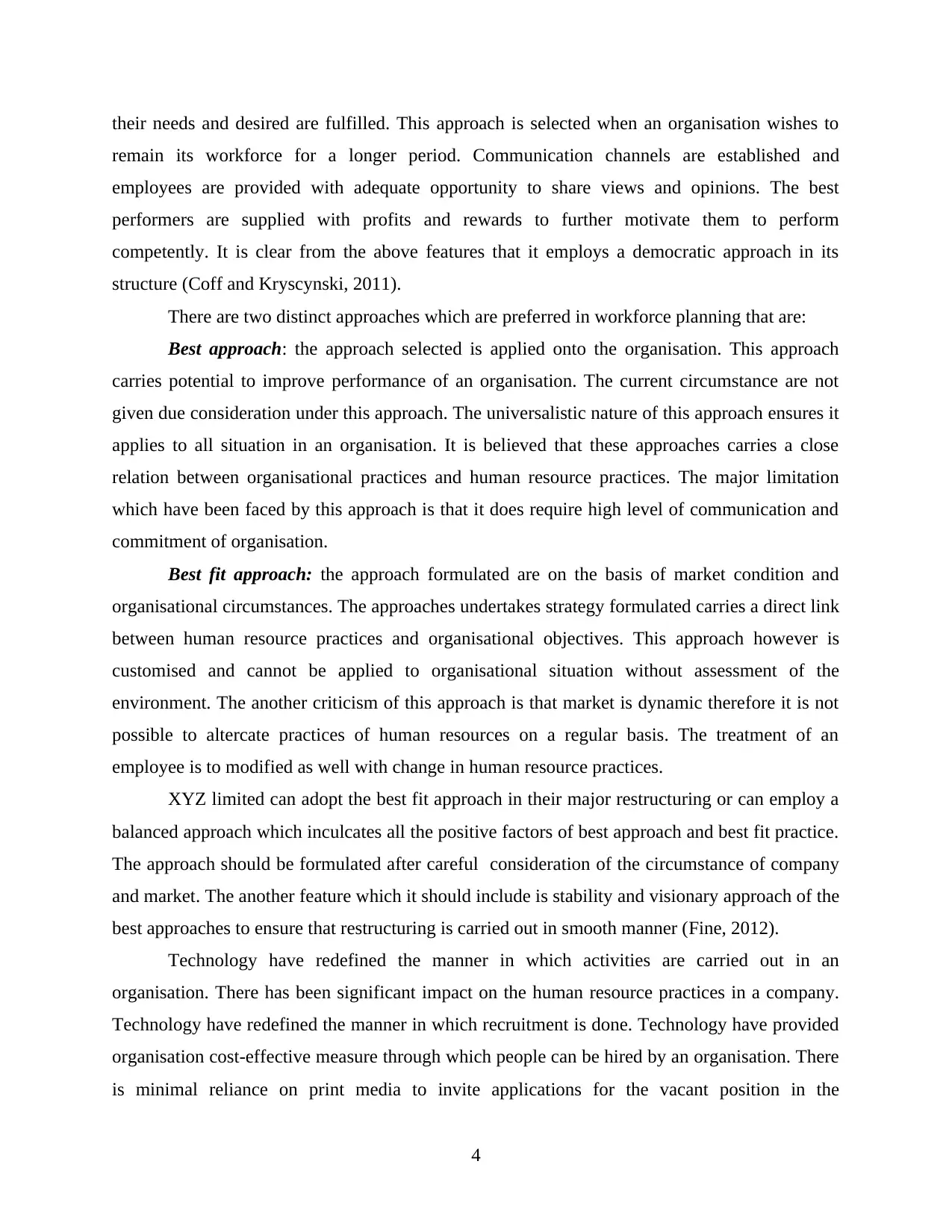
their needs and desired are fulfilled. This approach is selected when an organisation wishes to
remain its workforce for a longer period. Communication channels are established and
employees are provided with adequate opportunity to share views and opinions. The best
performers are supplied with profits and rewards to further motivate them to perform
competently. It is clear from the above features that it employs a democratic approach in its
structure (Coff and Kryscynski, 2011).
There are two distinct approaches which are preferred in workforce planning that are:
Best approach: the approach selected is applied onto the organisation. This approach
carries potential to improve performance of an organisation. The current circumstance are not
given due consideration under this approach. The universalistic nature of this approach ensures it
applies to all situation in an organisation. It is believed that these approaches carries a close
relation between organisational practices and human resource practices. The major limitation
which have been faced by this approach is that it does require high level of communication and
commitment of organisation.
Best fit approach: the approach formulated are on the basis of market condition and
organisational circumstances. The approaches undertakes strategy formulated carries a direct link
between human resource practices and organisational objectives. This approach however is
customised and cannot be applied to organisational situation without assessment of the
environment. The another criticism of this approach is that market is dynamic therefore it is not
possible to altercate practices of human resources on a regular basis. The treatment of an
employee is to modified as well with change in human resource practices.
XYZ limited can adopt the best fit approach in their major restructuring or can employ a
balanced approach which inculcates all the positive factors of best approach and best fit practice.
The approach should be formulated after careful consideration of the circumstance of company
and market. The another feature which it should include is stability and visionary approach of the
best approaches to ensure that restructuring is carried out in smooth manner (Fine, 2012).
Technology have redefined the manner in which activities are carried out in an
organisation. There has been significant impact on the human resource practices in a company.
Technology have redefined the manner in which recruitment is done. Technology have provided
organisation cost-effective measure through which people can be hired by an organisation. There
is minimal reliance on print media to invite applications for the vacant position in the
4
remain its workforce for a longer period. Communication channels are established and
employees are provided with adequate opportunity to share views and opinions. The best
performers are supplied with profits and rewards to further motivate them to perform
competently. It is clear from the above features that it employs a democratic approach in its
structure (Coff and Kryscynski, 2011).
There are two distinct approaches which are preferred in workforce planning that are:
Best approach: the approach selected is applied onto the organisation. This approach
carries potential to improve performance of an organisation. The current circumstance are not
given due consideration under this approach. The universalistic nature of this approach ensures it
applies to all situation in an organisation. It is believed that these approaches carries a close
relation between organisational practices and human resource practices. The major limitation
which have been faced by this approach is that it does require high level of communication and
commitment of organisation.
Best fit approach: the approach formulated are on the basis of market condition and
organisational circumstances. The approaches undertakes strategy formulated carries a direct link
between human resource practices and organisational objectives. This approach however is
customised and cannot be applied to organisational situation without assessment of the
environment. The another criticism of this approach is that market is dynamic therefore it is not
possible to altercate practices of human resources on a regular basis. The treatment of an
employee is to modified as well with change in human resource practices.
XYZ limited can adopt the best fit approach in their major restructuring or can employ a
balanced approach which inculcates all the positive factors of best approach and best fit practice.
The approach should be formulated after careful consideration of the circumstance of company
and market. The another feature which it should include is stability and visionary approach of the
best approaches to ensure that restructuring is carried out in smooth manner (Fine, 2012).
Technology have redefined the manner in which activities are carried out in an
organisation. There has been significant impact on the human resource practices in a company.
Technology have redefined the manner in which recruitment is done. Technology have provided
organisation cost-effective measure through which people can be hired by an organisation. There
is minimal reliance on print media to invite applications for the vacant position in the
4
⊘ This is a preview!⊘
Do you want full access?
Subscribe today to unlock all pages.

Trusted by 1+ million students worldwide
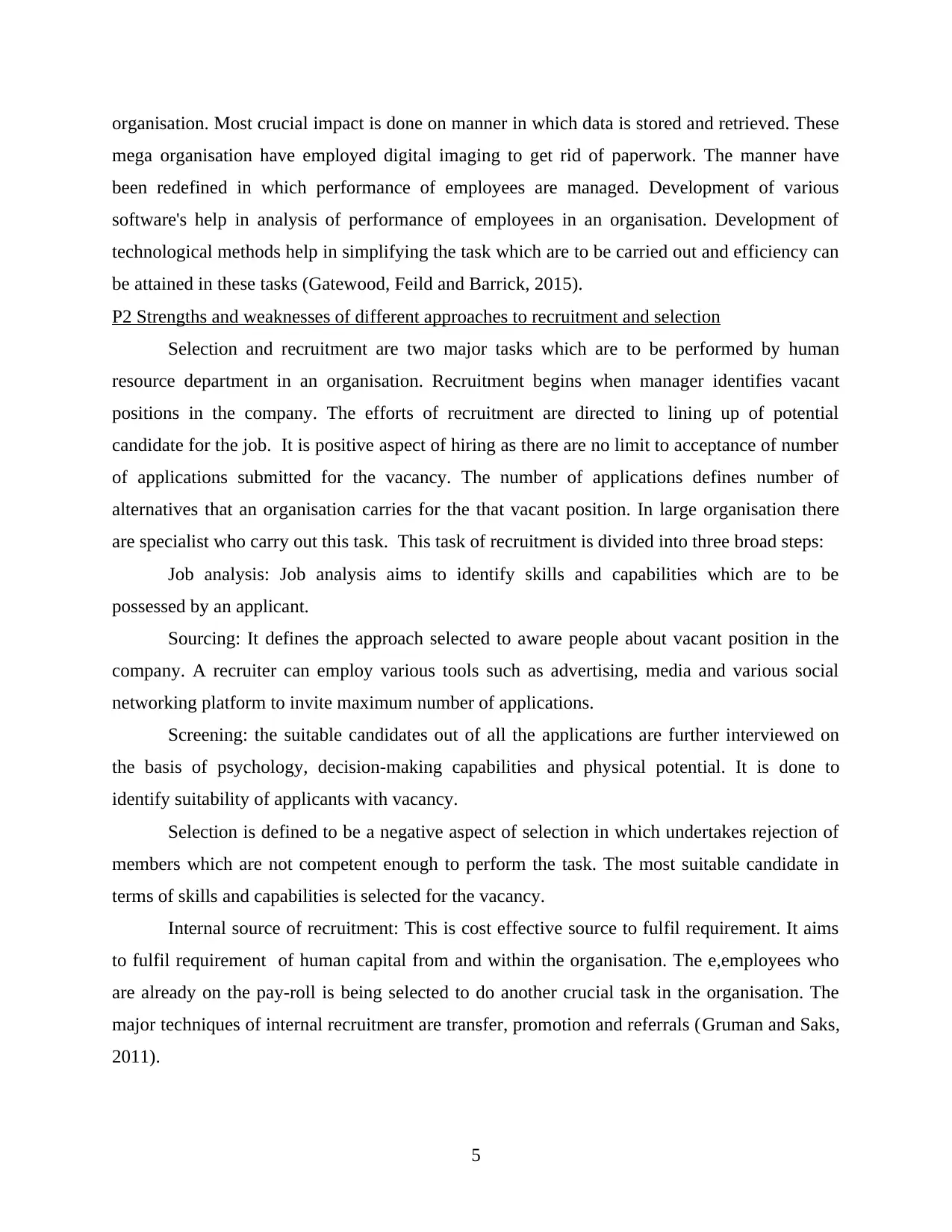
organisation. Most crucial impact is done on manner in which data is stored and retrieved. These
mega organisation have employed digital imaging to get rid of paperwork. The manner have
been redefined in which performance of employees are managed. Development of various
software's help in analysis of performance of employees in an organisation. Development of
technological methods help in simplifying the task which are to be carried out and efficiency can
be attained in these tasks (Gatewood, Feild and Barrick, 2015).
P2 Strengths and weaknesses of different approaches to recruitment and selection
Selection and recruitment are two major tasks which are to be performed by human
resource department in an organisation. Recruitment begins when manager identifies vacant
positions in the company. The efforts of recruitment are directed to lining up of potential
candidate for the job. It is positive aspect of hiring as there are no limit to acceptance of number
of applications submitted for the vacancy. The number of applications defines number of
alternatives that an organisation carries for the that vacant position. In large organisation there
are specialist who carry out this task. This task of recruitment is divided into three broad steps:
Job analysis: Job analysis aims to identify skills and capabilities which are to be
possessed by an applicant.
Sourcing: It defines the approach selected to aware people about vacant position in the
company. A recruiter can employ various tools such as advertising, media and various social
networking platform to invite maximum number of applications.
Screening: the suitable candidates out of all the applications are further interviewed on
the basis of psychology, decision-making capabilities and physical potential. It is done to
identify suitability of applicants with vacancy.
Selection is defined to be a negative aspect of selection in which undertakes rejection of
members which are not competent enough to perform the task. The most suitable candidate in
terms of skills and capabilities is selected for the vacancy.
Internal source of recruitment: This is cost effective source to fulfil requirement. It aims
to fulfil requirement of human capital from and within the organisation. The e,employees who
are already on the pay-roll is being selected to do another crucial task in the organisation. The
major techniques of internal recruitment are transfer, promotion and referrals (Gruman and Saks,
2011).
5
mega organisation have employed digital imaging to get rid of paperwork. The manner have
been redefined in which performance of employees are managed. Development of various
software's help in analysis of performance of employees in an organisation. Development of
technological methods help in simplifying the task which are to be carried out and efficiency can
be attained in these tasks (Gatewood, Feild and Barrick, 2015).
P2 Strengths and weaknesses of different approaches to recruitment and selection
Selection and recruitment are two major tasks which are to be performed by human
resource department in an organisation. Recruitment begins when manager identifies vacant
positions in the company. The efforts of recruitment are directed to lining up of potential
candidate for the job. It is positive aspect of hiring as there are no limit to acceptance of number
of applications submitted for the vacancy. The number of applications defines number of
alternatives that an organisation carries for the that vacant position. In large organisation there
are specialist who carry out this task. This task of recruitment is divided into three broad steps:
Job analysis: Job analysis aims to identify skills and capabilities which are to be
possessed by an applicant.
Sourcing: It defines the approach selected to aware people about vacant position in the
company. A recruiter can employ various tools such as advertising, media and various social
networking platform to invite maximum number of applications.
Screening: the suitable candidates out of all the applications are further interviewed on
the basis of psychology, decision-making capabilities and physical potential. It is done to
identify suitability of applicants with vacancy.
Selection is defined to be a negative aspect of selection in which undertakes rejection of
members which are not competent enough to perform the task. The most suitable candidate in
terms of skills and capabilities is selected for the vacancy.
Internal source of recruitment: This is cost effective source to fulfil requirement. It aims
to fulfil requirement of human capital from and within the organisation. The e,employees who
are already on the pay-roll is being selected to do another crucial task in the organisation. The
major techniques of internal recruitment are transfer, promotion and referrals (Gruman and Saks,
2011).
5
Paraphrase This Document
Need a fresh take? Get an instant paraphrase of this document with our AI Paraphraser
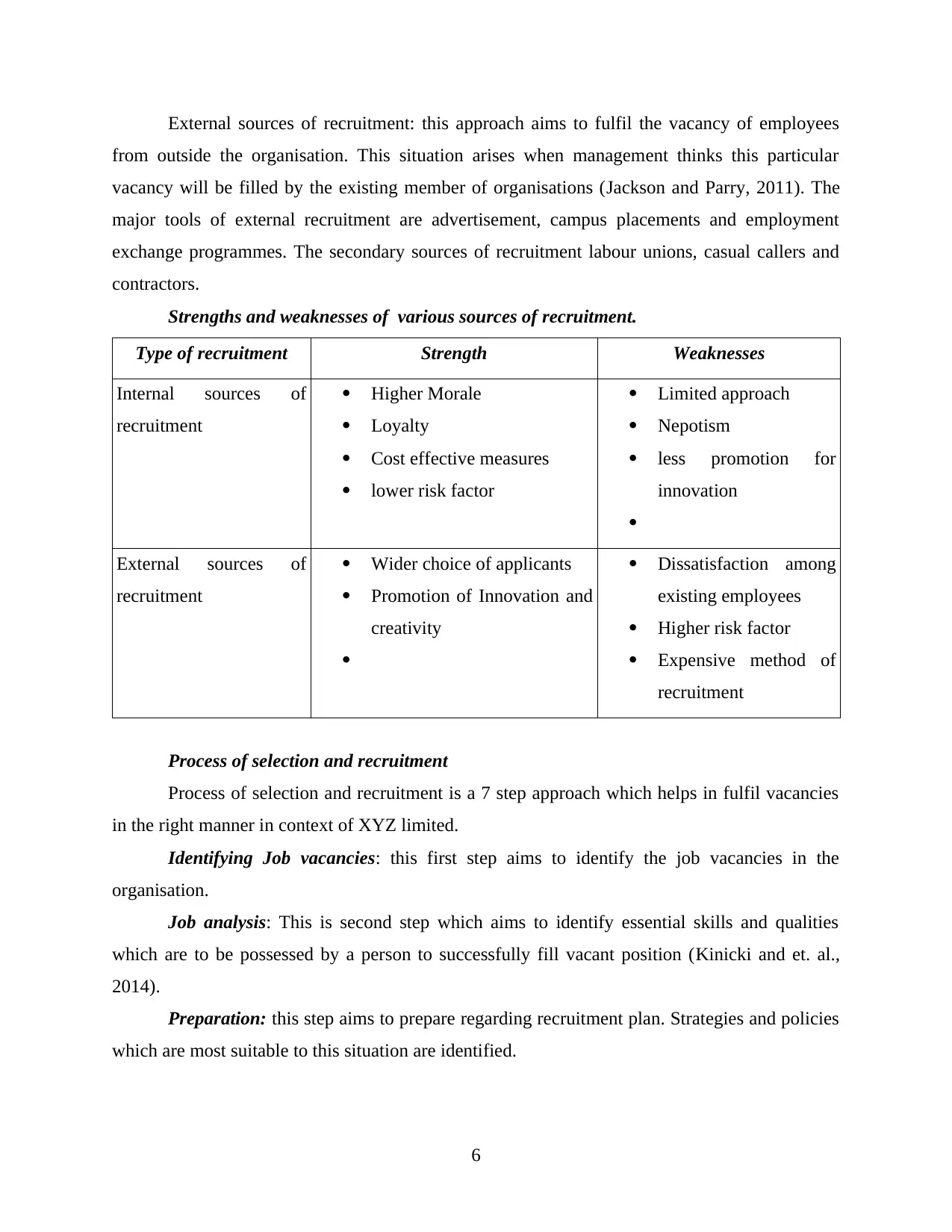
External sources of recruitment: this approach aims to fulfil the vacancy of employees
from outside the organisation. This situation arises when management thinks this particular
vacancy will be filled by the existing member of organisations (Jackson and Parry, 2011). The
major tools of external recruitment are advertisement, campus placements and employment
exchange programmes. The secondary sources of recruitment labour unions, casual callers and
contractors.
Strengths and weaknesses of various sources of recruitment.
Type of recruitment Strength Weaknesses
Internal sources of
recruitment
Higher Morale
Loyalty
Cost effective measures
lower risk factor
Limited approach
Nepotism
less promotion for
innovation
External sources of
recruitment
Wider choice of applicants
Promotion of Innovation and
creativity
Dissatisfaction among
existing employees
Higher risk factor
Expensive method of
recruitment
Process of selection and recruitment
Process of selection and recruitment is a 7 step approach which helps in fulfil vacancies
in the right manner in context of XYZ limited.
Identifying Job vacancies: this first step aims to identify the job vacancies in the
organisation.
Job analysis: This is second step which aims to identify essential skills and qualities
which are to be possessed by a person to successfully fill vacant position (Kinicki and et. al.,
2014).
Preparation: this step aims to prepare regarding recruitment plan. Strategies and policies
which are most suitable to this situation are identified.
6
from outside the organisation. This situation arises when management thinks this particular
vacancy will be filled by the existing member of organisations (Jackson and Parry, 2011). The
major tools of external recruitment are advertisement, campus placements and employment
exchange programmes. The secondary sources of recruitment labour unions, casual callers and
contractors.
Strengths and weaknesses of various sources of recruitment.
Type of recruitment Strength Weaknesses
Internal sources of
recruitment
Higher Morale
Loyalty
Cost effective measures
lower risk factor
Limited approach
Nepotism
less promotion for
innovation
External sources of
recruitment
Wider choice of applicants
Promotion of Innovation and
creativity
Dissatisfaction among
existing employees
Higher risk factor
Expensive method of
recruitment
Process of selection and recruitment
Process of selection and recruitment is a 7 step approach which helps in fulfil vacancies
in the right manner in context of XYZ limited.
Identifying Job vacancies: this first step aims to identify the job vacancies in the
organisation.
Job analysis: This is second step which aims to identify essential skills and qualities
which are to be possessed by a person to successfully fill vacant position (Kinicki and et. al.,
2014).
Preparation: this step aims to prepare regarding recruitment plan. Strategies and policies
which are most suitable to this situation are identified.
6
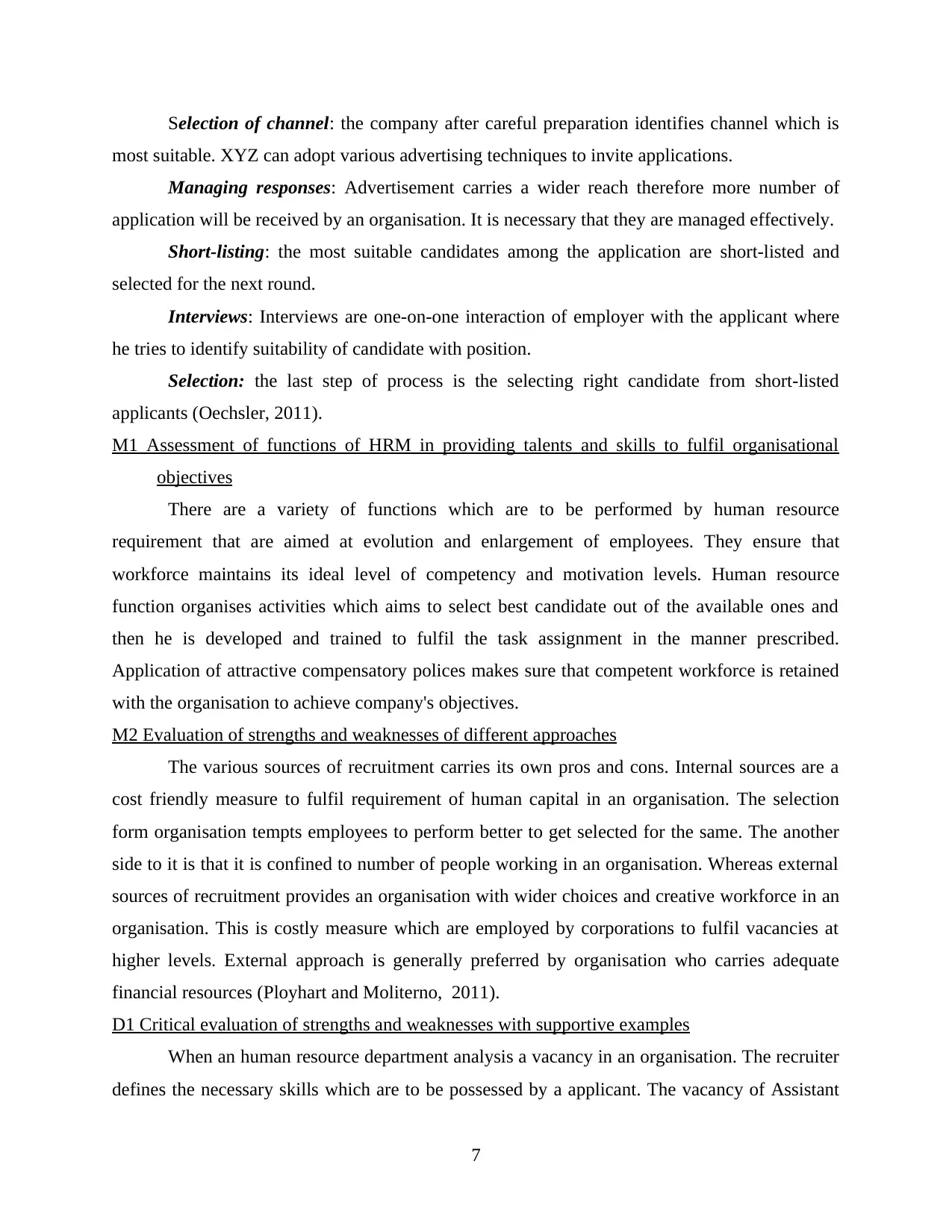
Selection of channel: the company after careful preparation identifies channel which is
most suitable. XYZ can adopt various advertising techniques to invite applications.
Managing responses: Advertisement carries a wider reach therefore more number of
application will be received by an organisation. It is necessary that they are managed effectively.
Short-listing: the most suitable candidates among the application are short-listed and
selected for the next round.
Interviews: Interviews are one-on-one interaction of employer with the applicant where
he tries to identify suitability of candidate with position.
Selection: the last step of process is the selecting right candidate from short-listed
applicants (Oechsler, 2011).
M1 Assessment of functions of HRM in providing talents and skills to fulfil organisational
objectives
There are a variety of functions which are to be performed by human resource
requirement that are aimed at evolution and enlargement of employees. They ensure that
workforce maintains its ideal level of competency and motivation levels. Human resource
function organises activities which aims to select best candidate out of the available ones and
then he is developed and trained to fulfil the task assignment in the manner prescribed.
Application of attractive compensatory polices makes sure that competent workforce is retained
with the organisation to achieve company's objectives.
M2 Evaluation of strengths and weaknesses of different approaches
The various sources of recruitment carries its own pros and cons. Internal sources are a
cost friendly measure to fulfil requirement of human capital in an organisation. The selection
form organisation tempts employees to perform better to get selected for the same. The another
side to it is that it is confined to number of people working in an organisation. Whereas external
sources of recruitment provides an organisation with wider choices and creative workforce in an
organisation. This is costly measure which are employed by corporations to fulfil vacancies at
higher levels. External approach is generally preferred by organisation who carries adequate
financial resources (Ployhart and Moliterno, 2011).
D1 Critical evaluation of strengths and weaknesses with supportive examples
When an human resource department analysis a vacancy in an organisation. The recruiter
defines the necessary skills which are to be possessed by a applicant. The vacancy of Assistant
7
most suitable. XYZ can adopt various advertising techniques to invite applications.
Managing responses: Advertisement carries a wider reach therefore more number of
application will be received by an organisation. It is necessary that they are managed effectively.
Short-listing: the most suitable candidates among the application are short-listed and
selected for the next round.
Interviews: Interviews are one-on-one interaction of employer with the applicant where
he tries to identify suitability of candidate with position.
Selection: the last step of process is the selecting right candidate from short-listed
applicants (Oechsler, 2011).
M1 Assessment of functions of HRM in providing talents and skills to fulfil organisational
objectives
There are a variety of functions which are to be performed by human resource
requirement that are aimed at evolution and enlargement of employees. They ensure that
workforce maintains its ideal level of competency and motivation levels. Human resource
function organises activities which aims to select best candidate out of the available ones and
then he is developed and trained to fulfil the task assignment in the manner prescribed.
Application of attractive compensatory polices makes sure that competent workforce is retained
with the organisation to achieve company's objectives.
M2 Evaluation of strengths and weaknesses of different approaches
The various sources of recruitment carries its own pros and cons. Internal sources are a
cost friendly measure to fulfil requirement of human capital in an organisation. The selection
form organisation tempts employees to perform better to get selected for the same. The another
side to it is that it is confined to number of people working in an organisation. Whereas external
sources of recruitment provides an organisation with wider choices and creative workforce in an
organisation. This is costly measure which are employed by corporations to fulfil vacancies at
higher levels. External approach is generally preferred by organisation who carries adequate
financial resources (Ployhart and Moliterno, 2011).
D1 Critical evaluation of strengths and weaknesses with supportive examples
When an human resource department analysis a vacancy in an organisation. The recruiter
defines the necessary skills which are to be possessed by a applicant. The vacancy of Assistant
7
⊘ This is a preview!⊘
Do you want full access?
Subscribe today to unlock all pages.

Trusted by 1+ million students worldwide
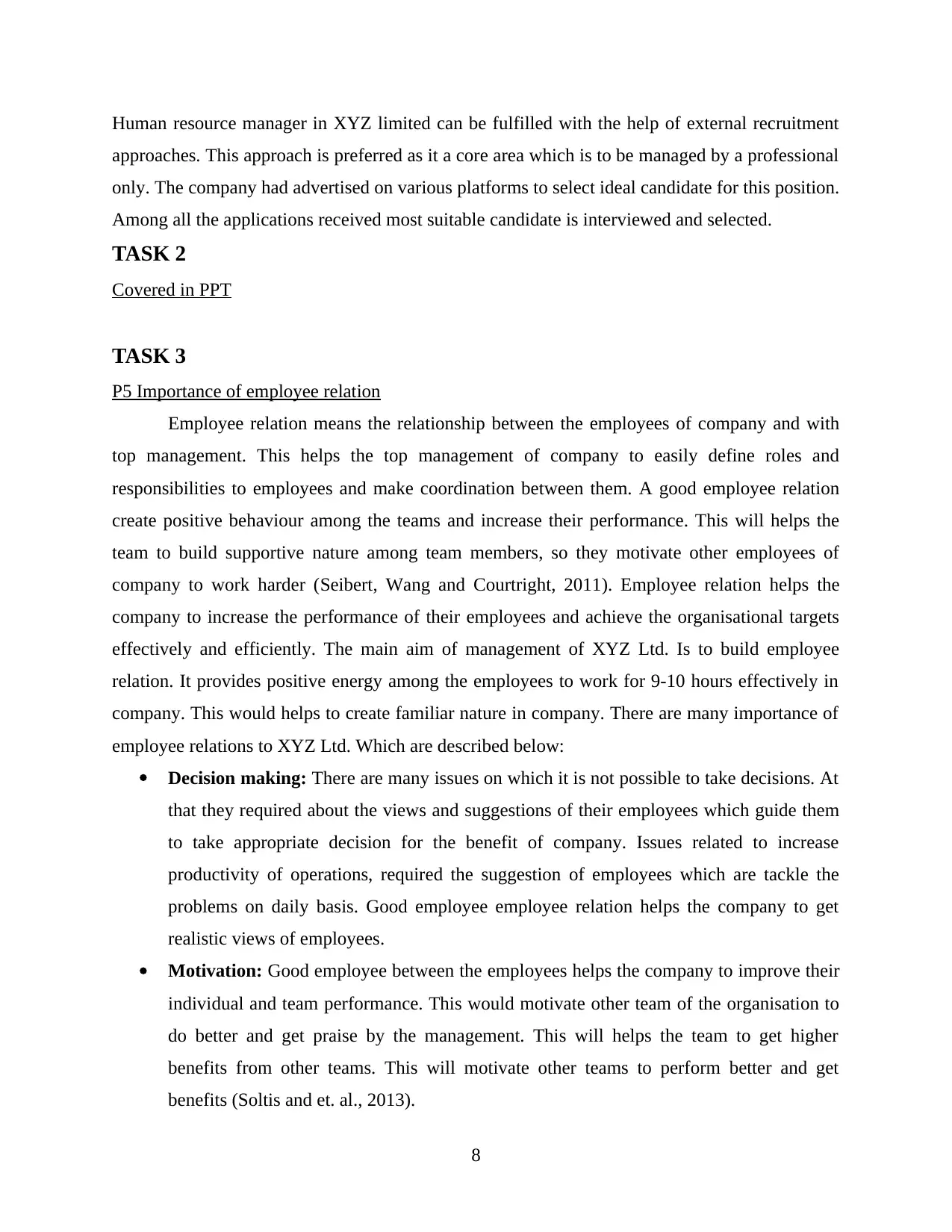
Human resource manager in XYZ limited can be fulfilled with the help of external recruitment
approaches. This approach is preferred as it a core area which is to be managed by a professional
only. The company had advertised on various platforms to select ideal candidate for this position.
Among all the applications received most suitable candidate is interviewed and selected.
TASK 2
Covered in PPT
TASK 3
P5 Importance of employee relation
Employee relation means the relationship between the employees of company and with
top management. This helps the top management of company to easily define roles and
responsibilities to employees and make coordination between them. A good employee relation
create positive behaviour among the teams and increase their performance. This will helps the
team to build supportive nature among team members, so they motivate other employees of
company to work harder (Seibert, Wang and Courtright, 2011). Employee relation helps the
company to increase the performance of their employees and achieve the organisational targets
effectively and efficiently. The main aim of management of XYZ Ltd. Is to build employee
relation. It provides positive energy among the employees to work for 9-10 hours effectively in
company. This would helps to create familiar nature in company. There are many importance of
employee relations to XYZ Ltd. Which are described below:
Decision making: There are many issues on which it is not possible to take decisions. At
that they required about the views and suggestions of their employees which guide them
to take appropriate decision for the benefit of company. Issues related to increase
productivity of operations, required the suggestion of employees which are tackle the
problems on daily basis. Good employee employee relation helps the company to get
realistic views of employees.
Motivation: Good employee between the employees helps the company to improve their
individual and team performance. This would motivate other team of the organisation to
do better and get praise by the management. This will helps the team to get higher
benefits from other teams. This will motivate other teams to perform better and get
benefits (Soltis and et. al., 2013).
8
approaches. This approach is preferred as it a core area which is to be managed by a professional
only. The company had advertised on various platforms to select ideal candidate for this position.
Among all the applications received most suitable candidate is interviewed and selected.
TASK 2
Covered in PPT
TASK 3
P5 Importance of employee relation
Employee relation means the relationship between the employees of company and with
top management. This helps the top management of company to easily define roles and
responsibilities to employees and make coordination between them. A good employee relation
create positive behaviour among the teams and increase their performance. This will helps the
team to build supportive nature among team members, so they motivate other employees of
company to work harder (Seibert, Wang and Courtright, 2011). Employee relation helps the
company to increase the performance of their employees and achieve the organisational targets
effectively and efficiently. The main aim of management of XYZ Ltd. Is to build employee
relation. It provides positive energy among the employees to work for 9-10 hours effectively in
company. This would helps to create familiar nature in company. There are many importance of
employee relations to XYZ Ltd. Which are described below:
Decision making: There are many issues on which it is not possible to take decisions. At
that they required about the views and suggestions of their employees which guide them
to take appropriate decision for the benefit of company. Issues related to increase
productivity of operations, required the suggestion of employees which are tackle the
problems on daily basis. Good employee employee relation helps the company to get
realistic views of employees.
Motivation: Good employee between the employees helps the company to improve their
individual and team performance. This would motivate other team of the organisation to
do better and get praise by the management. This will helps the team to get higher
benefits from other teams. This will motivate other teams to perform better and get
benefits (Soltis and et. al., 2013).
8
Paraphrase This Document
Need a fresh take? Get an instant paraphrase of this document with our AI Paraphraser
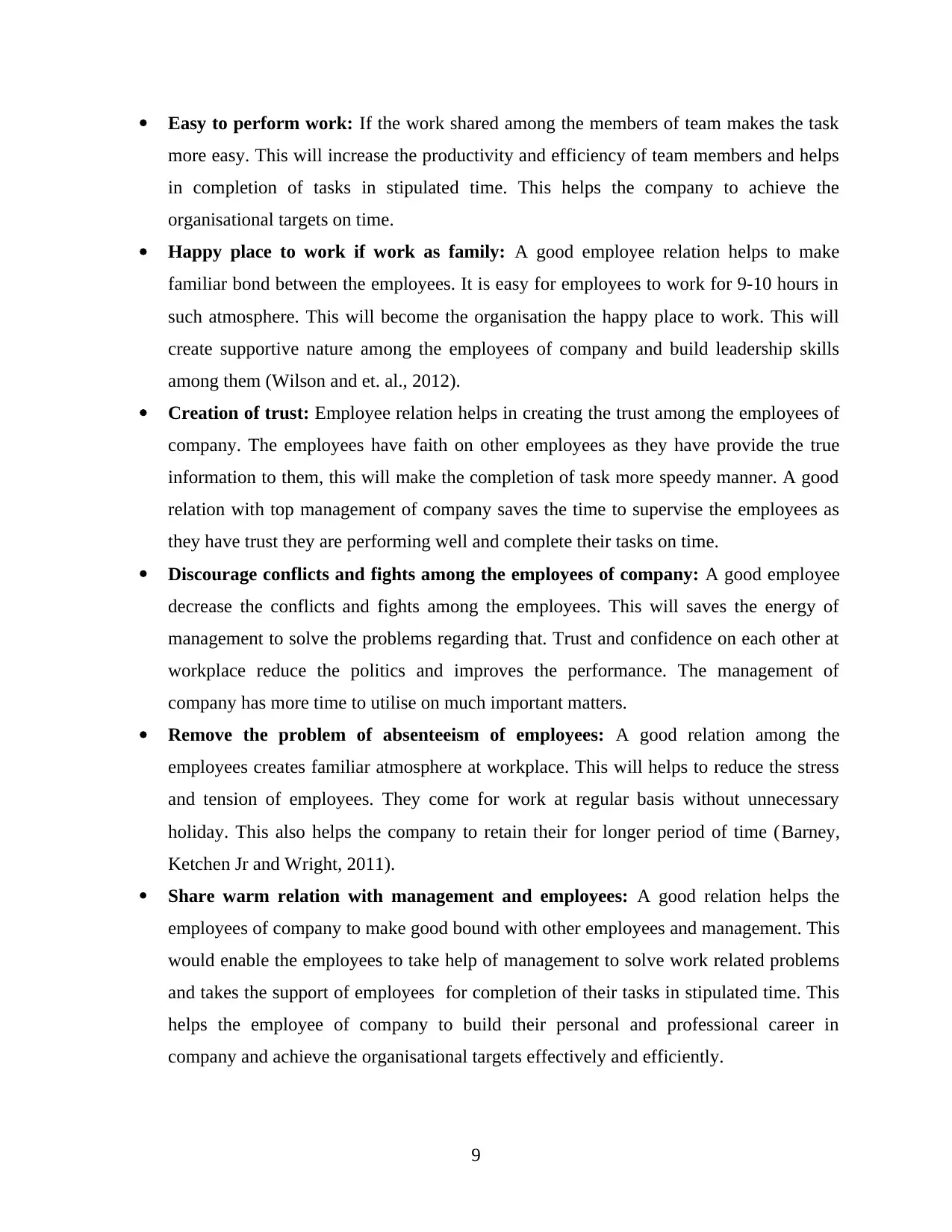
Easy to perform work: If the work shared among the members of team makes the task
more easy. This will increase the productivity and efficiency of team members and helps
in completion of tasks in stipulated time. This helps the company to achieve the
organisational targets on time.
Happy place to work if work as family: A good employee relation helps to make
familiar bond between the employees. It is easy for employees to work for 9-10 hours in
such atmosphere. This will become the organisation the happy place to work. This will
create supportive nature among the employees of company and build leadership skills
among them (Wilson and et. al., 2012).
Creation of trust: Employee relation helps in creating the trust among the employees of
company. The employees have faith on other employees as they have provide the true
information to them, this will make the completion of task more speedy manner. A good
relation with top management of company saves the time to supervise the employees as
they have trust they are performing well and complete their tasks on time.
Discourage conflicts and fights among the employees of company: A good employee
decrease the conflicts and fights among the employees. This will saves the energy of
management to solve the problems regarding that. Trust and confidence on each other at
workplace reduce the politics and improves the performance. The management of
company has more time to utilise on much important matters.
Remove the problem of absenteeism of employees: A good relation among the
employees creates familiar atmosphere at workplace. This will helps to reduce the stress
and tension of employees. They come for work at regular basis without unnecessary
holiday. This also helps the company to retain their for longer period of time (Barney,
Ketchen Jr and Wright, 2011).
Share warm relation with management and employees: A good relation helps the
employees of company to make good bound with other employees and management. This
would enable the employees to take help of management to solve work related problems
and takes the support of employees for completion of their tasks in stipulated time. This
helps the employee of company to build their personal and professional career in
company and achieve the organisational targets effectively and efficiently.
9
more easy. This will increase the productivity and efficiency of team members and helps
in completion of tasks in stipulated time. This helps the company to achieve the
organisational targets on time.
Happy place to work if work as family: A good employee relation helps to make
familiar bond between the employees. It is easy for employees to work for 9-10 hours in
such atmosphere. This will become the organisation the happy place to work. This will
create supportive nature among the employees of company and build leadership skills
among them (Wilson and et. al., 2012).
Creation of trust: Employee relation helps in creating the trust among the employees of
company. The employees have faith on other employees as they have provide the true
information to them, this will make the completion of task more speedy manner. A good
relation with top management of company saves the time to supervise the employees as
they have trust they are performing well and complete their tasks on time.
Discourage conflicts and fights among the employees of company: A good employee
decrease the conflicts and fights among the employees. This will saves the energy of
management to solve the problems regarding that. Trust and confidence on each other at
workplace reduce the politics and improves the performance. The management of
company has more time to utilise on much important matters.
Remove the problem of absenteeism of employees: A good relation among the
employees creates familiar atmosphere at workplace. This will helps to reduce the stress
and tension of employees. They come for work at regular basis without unnecessary
holiday. This also helps the company to retain their for longer period of time (Barney,
Ketchen Jr and Wright, 2011).
Share warm relation with management and employees: A good relation helps the
employees of company to make good bound with other employees and management. This
would enable the employees to take help of management to solve work related problems
and takes the support of employees for completion of their tasks in stipulated time. This
helps the employee of company to build their personal and professional career in
company and achieve the organisational targets effectively and efficiently.
9
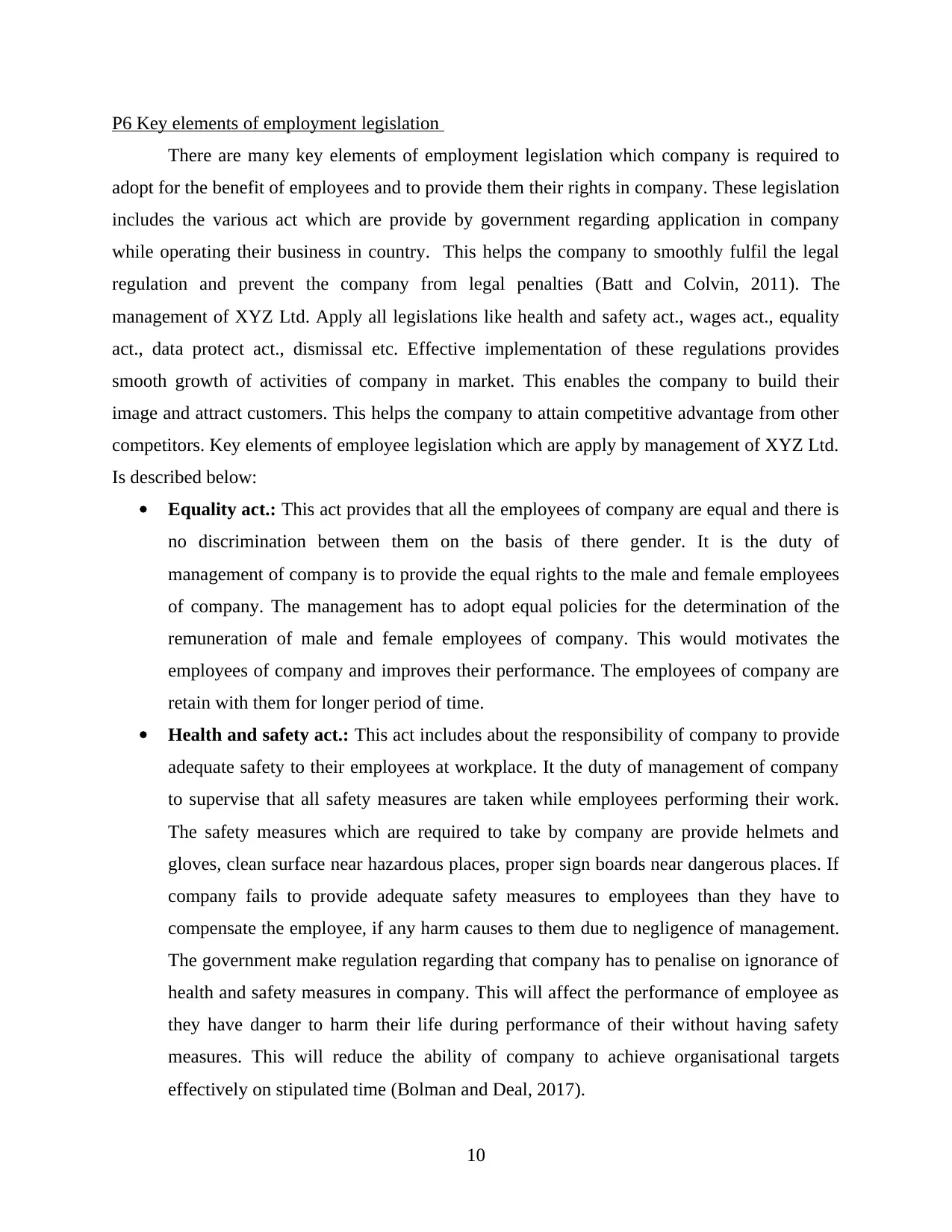
P6 Key elements of employment legislation
There are many key elements of employment legislation which company is required to
adopt for the benefit of employees and to provide them their rights in company. These legislation
includes the various act which are provide by government regarding application in company
while operating their business in country. This helps the company to smoothly fulfil the legal
regulation and prevent the company from legal penalties (Batt and Colvin, 2011). The
management of XYZ Ltd. Apply all legislations like health and safety act., wages act., equality
act., data protect act., dismissal etc. Effective implementation of these regulations provides
smooth growth of activities of company in market. This enables the company to build their
image and attract customers. This helps the company to attain competitive advantage from other
competitors. Key elements of employee legislation which are apply by management of XYZ Ltd.
Is described below:
Equality act.: This act provides that all the employees of company are equal and there is
no discrimination between them on the basis of there gender. It is the duty of
management of company is to provide the equal rights to the male and female employees
of company. The management has to adopt equal policies for the determination of the
remuneration of male and female employees of company. This would motivates the
employees of company and improves their performance. The employees of company are
retain with them for longer period of time.
Health and safety act.: This act includes about the responsibility of company to provide
adequate safety to their employees at workplace. It the duty of management of company
to supervise that all safety measures are taken while employees performing their work.
The safety measures which are required to take by company are provide helmets and
gloves, clean surface near hazardous places, proper sign boards near dangerous places. If
company fails to provide adequate safety measures to employees than they have to
compensate the employee, if any harm causes to them due to negligence of management.
The government make regulation regarding that company has to penalise on ignorance of
health and safety measures in company. This will affect the performance of employee as
they have danger to harm their life during performance of their without having safety
measures. This will reduce the ability of company to achieve organisational targets
effectively on stipulated time (Bolman and Deal, 2017).
10
There are many key elements of employment legislation which company is required to
adopt for the benefit of employees and to provide them their rights in company. These legislation
includes the various act which are provide by government regarding application in company
while operating their business in country. This helps the company to smoothly fulfil the legal
regulation and prevent the company from legal penalties (Batt and Colvin, 2011). The
management of XYZ Ltd. Apply all legislations like health and safety act., wages act., equality
act., data protect act., dismissal etc. Effective implementation of these regulations provides
smooth growth of activities of company in market. This enables the company to build their
image and attract customers. This helps the company to attain competitive advantage from other
competitors. Key elements of employee legislation which are apply by management of XYZ Ltd.
Is described below:
Equality act.: This act provides that all the employees of company are equal and there is
no discrimination between them on the basis of there gender. It is the duty of
management of company is to provide the equal rights to the male and female employees
of company. The management has to adopt equal policies for the determination of the
remuneration of male and female employees of company. This would motivates the
employees of company and improves their performance. The employees of company are
retain with them for longer period of time.
Health and safety act.: This act includes about the responsibility of company to provide
adequate safety to their employees at workplace. It the duty of management of company
to supervise that all safety measures are taken while employees performing their work.
The safety measures which are required to take by company are provide helmets and
gloves, clean surface near hazardous places, proper sign boards near dangerous places. If
company fails to provide adequate safety measures to employees than they have to
compensate the employee, if any harm causes to them due to negligence of management.
The government make regulation regarding that company has to penalise on ignorance of
health and safety measures in company. This will affect the performance of employee as
they have danger to harm their life during performance of their without having safety
measures. This will reduce the ability of company to achieve organisational targets
effectively on stipulated time (Bolman and Deal, 2017).
10
⊘ This is a preview!⊘
Do you want full access?
Subscribe today to unlock all pages.

Trusted by 1+ million students worldwide
1 out of 18
Related Documents
Your All-in-One AI-Powered Toolkit for Academic Success.
+13062052269
info@desklib.com
Available 24*7 on WhatsApp / Email
![[object Object]](/_next/static/media/star-bottom.7253800d.svg)
Unlock your academic potential
Copyright © 2020–2025 A2Z Services. All Rights Reserved. Developed and managed by ZUCOL.





